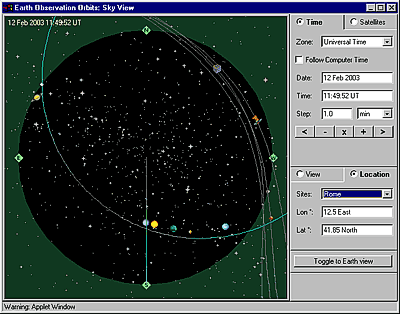Eyeing orbits from a new perspective - your PC
Ever wonder where your favourite ESA Earth observation satellites are, right now?
Now that curiosity can be satisfied from your PC, thanks to ESA’s Satellites in Orbits website and the new addition of its Earth observation missions. The Earth Observation Orbits site displays real-time information and animations about the orbital tracks and current locations of ESA’s Earth imaging satellites that were launched to help us better understand our own planet.
The interactive display includes a 3D model of the Earth and the ESA Earth observation satellites orbiting it, including:
- ERS-1 and -2, ESA’s first spacecraft providing global measurements of earth's atmospheric and surface properties using advanced microwave techniques. ERS-1, although still orbiting, was retired from service in 2000;
- Envisat, Europe's largest and most capable Earth observation satellite, launched last year with a suite of ten sensors to measure various aspects of the Earth’s atmosphere, ocean, land, and ice;
- Proba, short for Project for On-Board Autonomy, a mini-satellite measuring only 60x60x80 cm to demonstrate advanced spacecraft and imagery technologies.
Perspectives on the sky and Earth

On the Orbits website the display, you control several interactive perspectives on the satellites with the capability of toggling between them. You can alter the time, rotate the view, zoom in and out, and learn more about the various satellites and their missions.
The "Earth View" offers a unique perspective on the Earth and the orbital tracks of the EO satellites, presented as if you were "standing" thousands of kilometres high in space and looking "down" on the Earth and the satellites below.
The perspective can be zoomed and rotated to create dazzling views of the Earth and outline clearly the areas of the globe visited by the Earth observation satellites. By “grabbing” the display with your mouse or using the controls on the display, you can rotate the view of the sky and zoom in on particular spots in the sky. By animating the display with the video controls you can watch the stately procession of the ESA spacecraft as they travel in a never-ending circle between the North and South Poles with the Earth rotating underneath them.

A "Sky View" shows the satellites that along with the Moon, planets and stars, are visible from any location on Earth. It also displays the Moon, planets and major stars that are visible or just below the horizon for a particular location, date and time.
By choosing the Location radio button, you can enter longitude and latitude settings, or pick from a drop-down list of selected world cities, for a glimpse of the visible sky from that location, including the orbital tracks and current location of the spacecraft.
Like the Earth View, you can move and rotate the display, as well as zoom in on particular spots in the sky. By entering date and time parameters, different sky views are presented and then animated by using VCR-type controls to see how the sky and satellite positions change over time.
The positions of the satellites are defined by two-line orbital element (TLE) data. The TLEs are provided by the North American Aerospace Defense Command, better known as NORAD, which tracks all manmade objects in space. The information is updated weekly, on average, to ensure that the satellite positions are as accurate as possible within a 40-day window, forward and back, from the time set on your computer.
For the best view of the site, you’ll need to have Java Virtual machine and the Flash Plug-in installed on your computer. If you don’t have these, you’ll see links for these add-ons.
Come and take a look if your favourite ESA Earth observation satellite is over your neighbourhood right now by visiting Earth Observation Orbits. Depending on your Internet connection, the applet could take a few moments to load.





